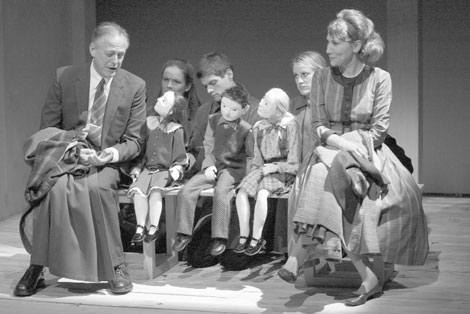By Davida Singer
Dramatist Paula Vogel often tells her students at Brown University that “we as playwrights have to be fearless”, and she doesn’t leave herself out of the equation. The author of numerous acclaimed plays like “The Baltimore Waltz”, “Mineola Twins” and “The Oldest Profession” has taken a leap in a new direction with “The Long Christmas Ride Home”- her very own puppet play and first full-length since her Pulitzer Prize winner, “How I Learned To Drive.”
Directed by Mark Brokaw, with puppets designed by Basil Twist, “The Long Christmas Ride Home” involves a family car spun out of control – following a disastrous holiday dinner – and three siblings hurled into the future where they confront remnants of childhood.
In town for rehearsals and the play’s opening performances at the Vineyard, Vogel discussed her latest venture and the current climate of American theater.
DS: What are your favorite themes to write about?
PV: I don’t think in terms of themes, but techniques. I’ve never written or seen a play like this. It’s “A Christmas Carol” meets “The Ice Storm.” Is it autobiographical? No, there are no puppets in my family. But there is commonality with “How I Learned To Drive.” I’ve done a lot of research on cars, and this also takes place in one- in the back seat. I’ve been working on it in my head since “How I Learned To Drive” was produced, and I did a huge amount of reading for it about Japanese theater, and Western puppet plays and the works of Wilder. It’s also an homage to his short plays, especially “Our Town” and “Christmas Dinner.”
DS: Why are you using puppetry here?
PV: An image came into my head. I was thinking of how I could get a new angle on childhood and adult perspective. It’s very much an adult puppet play- certainly not “Avenue Q”-but you can use the same techniques for something much more serious. In Japan, Bunraku is a serious form, and I thought that was intriguing. It’s also close to a music piece with music and dance, and we have a percussionist-David Van Tieghem-who plays and underscores the soundtrack.
DS: How did you bring it all together?
PV: The play now makes complete sense, but at first we were all blinking at each other. As terrifying as it was to write this, how scary for the actors who never touched puppets before! Basil trained them in four weeks, and throughout the process I kept saying the puppets will show us how to do this. And they did. The child/adult world was experienced through process too by all in the production, and the designers created something beautiful. I think puppets allow us to do that. There’s a terrible beauty here.
DS: You’ve been teaching for 19 years. How do you view the present scene, and the future of theater?
PV: I’ve got former students with work all over the City, and it’s wonderful to see how they view the world in new and different ways. But I am worried about the future of theater, so in teaching, I’m here to make sure theater will be produced in 2010. What I’m perplexed about is that I’m told cynicism is the fashion today. But those who feel that don’t teach, or they wouldn’t feel that way. Is our 9/11 response to produce art that is jaded and cynical? It’s not my response to it.
DS: And what’s your response to this production?
PV: The newness of it is very challenging, and the size of it-with 12 people on stage. The puppets and Basil are the most delightful part. They’re absolutely entrancing, and I’m in the flush of puppet love. I think one thing that’s interesting is that it is post-9/11, and even in terrible times, when you look back, you can recognize there really is something beautiful.



































